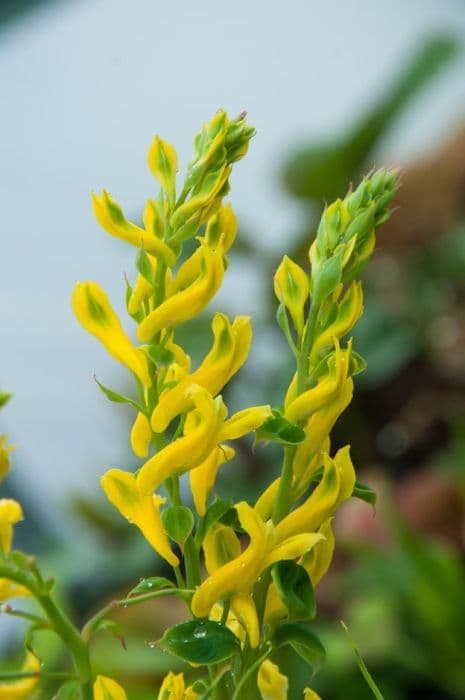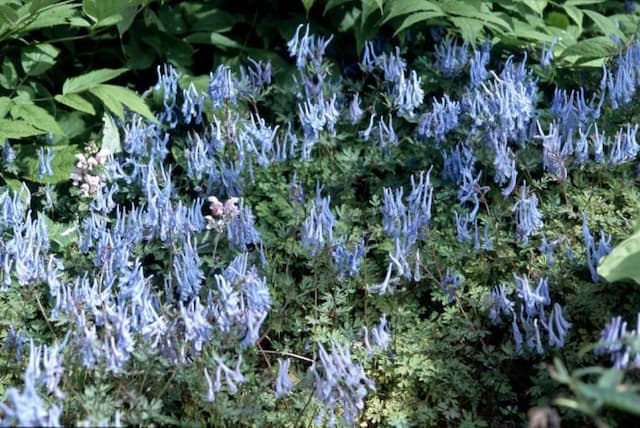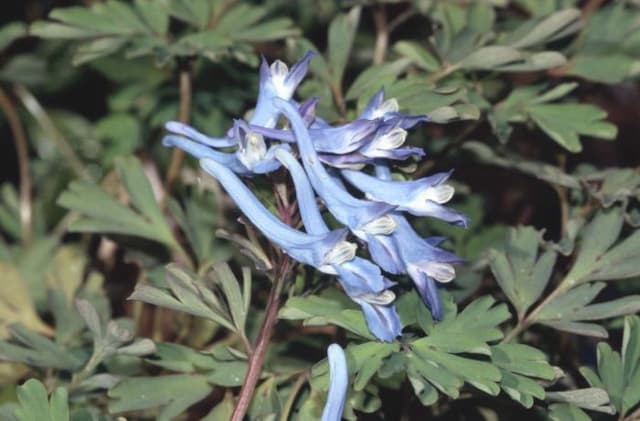Blue Poppy Meconopsis (Infertile Blue Group) 'Bobby Masterton'

ABOUT
Meconopsis 'Bobby Masterton' belongs to a unique grouping of perennial plants famed for their strikingly large, vivid blue flowers. Each blossom comprises four delicate petals, which create a breathtaking display against the contrasting golden-yellow center stamens. These petals have a soft, satiny texture and a captivating blue hue that's both rare and highly sought after among garden enthusiasts. The foliage is a lush green, with leaves that are typically elongated and somewhat toothed or lobed, giving the plant a clumpy, yet graceful appearance. The contrast between the intense blue flowers and the verdant leaves is a distinctive and attractive feature of the 'Bobby Masterton' cultivar.
About this plant
 Names
NamesFamily
Papaveraceae
Synonyms
Himalayan Blue Poppy, Tibetan Blue Poppy, Blue Poppy
Common names
Meconopsis (Infertile Blue Group) 'Bobby Masterton'.
 Toxicity
ToxicityTo humans
The plant commonly known as Himalayan Blue Poppy is not widely known to be toxic to humans. However, as with any plant material, sensitivity varies among individuals, and it is generally advised to avoid ingesting parts of the plant as they are not considered edible. There is no specific documentation on the symptoms of poisoning from the plant because it is not generally recognized as a toxic plant. Nevertheless, if ingestion occurs, it is advisable to consult a medical professional, especially if any adverse symptoms are observed.
To pets
Himalayan Blue Poppy is not commonly known to be toxic to pets. There is no widespread documentation suggesting that this plant is poisonous to animals. However, as pets can have different sensitivities, it's recommended to prevent them from ingesting plant material. If a pet does consume any part of the Himalayan Blue Poppy and shows signs of distress or illness, it is important to contact a veterinarian promptly.
 Characteristics
CharacteristicsLife cycle
Perennials
Foliage type
Deciduous
Color of leaves
Green
Flower color
Blue
Height
3 feet (91 cm)
Spread
1 foot (30 cm)
Plant type
Herb
Hardiness zones
7
Native area
Himalayas
Benefits
 General Benefits
General Benefits- Aesthetic Appeal: Produces vibrant blue flowers that can add a stunning pop of color to any garden or landscape.
- Garden Diversity: Introduces a unique species to the garden, which can help support biodiversity.
- Pollinator Attraction: Attracts bees, butterflies, and other pollinating insects, which are vital for the health of many other plants.
- Shade Tolerance: Can thrive in partially shaded conditions where other plants might struggle.
- Cool Weather Adaptation: Prefers cooler temperatures, making it a great choice for gardens in temperate regions or higher elevations.
- Low Maintenance: Requires minimal care once established, making it an easy addition for both novice and experienced gardeners.
- Non-Invasive: Unlike some garden plants, it is not known for being invasive, reducing maintenance and impact on local ecosystems.
- Emotional Wellbeing: The beauty and serene presence of the plant can contribute to a sense of tranquility and well-being in a garden setting.
- Seasonal Interest: Offers a unique and striking display in the spring and early summer when in bloom.
 Medical Properties
Medical PropertiesThis plant is not used for medical purposes.
 Air-purifying Qualities
Air-purifying QualitiesThis plant is not specifically known for air purifying qualities.
 Other Uses
Other Uses- Blue poppy petals can be used to create a natural dye for fabrics, yielding hues from light sky blues to deep indigos depending on the mordant used.
- The sap from the stems of blue poppies can sometimes be used as a mild, natural glue for emergency repairs of paper items.
- The seeds of the blue poppy, if properly treated, can be used in artistic creations like micro-mosaics for their uniform size and shape.
- The dried seed pods of blue poppies can be integrated into floral arrangements and crafts for their visual appeal and unique structure.
- As an educational tool, blue poppies can be useful in schools for teaching students about rare and endangered plants as well as conservation efforts.
- Blue poppies can be used in photography as a striking natural subject due to their vibrant color and delicate structure.
- When pressed and preserved, blue poppy flowers can be used in botanical artwork or as a decorative element in handmade paper making.
- The plant can play a role in cultural events or local festivals that celebrate alpine or Himalayan heritage, where the blue poppy is often a natural symbol.
- Insect photographers can utilize blue poppies in their gardens to attract and photograph pollinators like bees and butterflies.
- Gardeners might grow blue poppies as a challenge, to signify accomplishment in horticulture due to their reputation for being difficult to cultivate outside their native habitat.
Interesting Facts
 Feng Shui
Feng ShuiThe Blue Poppy is not used in Feng Shui practice.
 Zodiac Sign Compitability
Zodiac Sign CompitabilityThe Blue Poppy is not used in astrology practice.
 Plant Symbolism
Plant Symbolism- Rarity and Uniqueness: Meconopsis is known for its striking blue flowers which are rare in the plant kingdom, symbolizing uniqueness and the value of rarity in our lives.
- Peace and Tranquility: The blue of the Meconopsis, often referred to as blue poppy, evokes a sense of calm and peace, reminiscent of clear skies and still waters.
- Serene Beauty: The delicate and ethereal appearance of blue poppies conveys a sense of pure, untouched beauty, often associated with an ideal or a higher state of being.
- Overcoming Challenges: Growing blue poppies can be challenging as they require specific conditions, symbolizing the idea of overcoming difficulties to achieve success.
 Water
WaterThe Tibetan Blue Poppy should be watered deeply once a week, allowing the soil to become moist but not waterlogged. During hot spells or in particularly dry conditions, increase watering frequency to prevent the soil from drying out completely. Each watering session should provide enough water so that it reaches the roots, using approximately one gallon per plant, depending on the size and soil conditions. In winter, reduce watering to prevent soggy soil, which can lead to root rot. Always check the top inch of soil for dryness before watering.
 Light
LightTibetan Blue Poppies thrive in conditions with bright, indirect light or partial shade. They should be planted in a spot protected from harsh afternoon sun, which can scorch their delicate foliage and flowers. A location that receives morning light and afternoon shade is ideal for these plants to flourish.
 Temperature
TemperatureTibetan Blue Poppies prefer cooler temperatures and do best in environments where the temperature ranges between 50°F to 70°F. They can tolerate minimum temperatures down to around 32°F; however, prolonged exposure to temperatures below freezing can damage the plant. Maximum temperatures for healthy growth should not exceed 75°F, as higher temperatures can stress the plant.
 Pruning
PruningTibetan Blue Poppies require minimal pruning, mainly to remove spent flowers and to maintain plant appearance. Pruning should be done after the plant finishes flowering, usually in late summer or early fall. Prune back any dead or damaged stems to keep the plant healthy, and this can be done annually.
 Cleaning
CleaningAs needed
 Soil
SoilThe Himalayan Blue Poppy requires a soil mix rich in organic matter, with good drainage. A mix of equal parts loam, peat, and leaf mold, with added sharp sand for drainage, is ideal. The soil pH should be slightly acidic to neutral, in the range of 6.0 to 7.0.
 Repotting
RepottingHimalayan Blue Poppies should be repotted every year as they are sensitive to congested roots. Best done in late winter or early spring before the growing season starts.
 Humidity & Misting
Humidity & MistingHimalayan Blue Poppies flourish in a humid environment, ideally at a humidity level of around 60-70%, which simulates their native habitat conditions.
 Suitable locations
Suitable locationsIndoor
Ensure ample light, cool temps, and high humidity.
Outdoor
Partial shade, moist soil, protect from strong winds.
Hardiness zone
5-7 USDA
 Life cycle
Life cycleThe Blue Poppy 'Bobby Masterton' starts its life cycle as a seed sown in well-drained soil and in conditions mimicking its native alpine habitat. Upon germination, seedlings emerge and grow into young plants with a rosette of hairy, oblong leaves. As the plant matures, it develops tall, flowering stems that bear the characteristic large, showy blue flowers which are the hallmark of the 'Bobby Masterton' variety. After flowering, which typically occurs in late spring to early summer, the plant sets seed if pollination has occurred; however, 'Bobby Masterton' is infertile and does not generally produce viable seed. The plant is a perennial but often behaves as a monocarpic organism, dying after flowering, though some plants may survive to bloom again in subsequent years. To continue the life cycle, gardeners propagate 'Bobby Masterton' vegetatively from division or cuttings, as sexual reproduction through seeds is not typical for this cultivar.
 Propogation
PropogationPropogation time
Spring-Early Summer
Propogation: The Meconopsis, commonly known as the Himalayan blue poppy, particularly the 'Bobby Masterton' from the Infertile Blue Group, is typically propagated by seed. The best time to sow these seeds is in late winter to early spring. Fresh seeds should be sown on the surface of a moist, well-draining seed compost, with a light covering of soil or vermiculite. They require light for germination, so the containers should be placed in a bright position, but not in direct sunlight, and kept at a temperature of around 50 to 55 degrees Fahrenheit (10 to 13 degrees Celsius). It's crucial to maintain the humidity by covering the seed container with a piece of glass or clear plastic and to keep the soil consistently moist but not waterlogged. Seedlings should be carefully pricked out and grown on in cooler conditions once they are large enough to handle.









